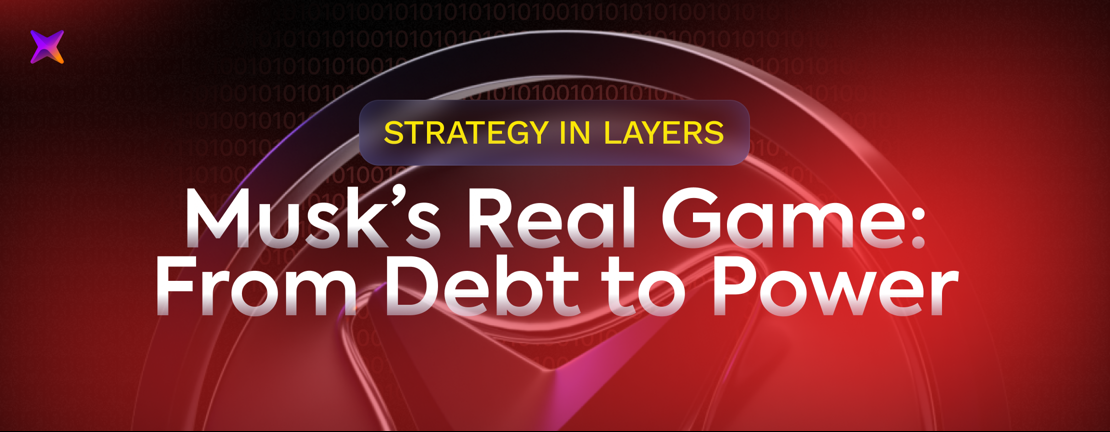Published 27 Oct 2025
Debt, Data, and Control — Musk’s Three Layers of Power

I’m the founder of RateXAI.
This isn’t fan content or some motivational quote with Elon’s face on it.
It’s a breakdown — how one person actually builds value from zero, makes mistakes, loses tens of billions, raises even more, changes the rules along the way, and still never gives up control.
We’ll look at it like an investigation. Cycle by cycle.
Where he burned out. Where he doubled down. Where he created value.
Here’s the key upfront: this isn’t a “genius who saw it all coming” story.
It’s a martingale. He goes in, loses, adds more, bends the rules to his advantage — and the market eventually agrees it’s worth more.
Let’s go year by year, share by share.
2022 → Negative Start
October 2022. Musk buys Twitter for about $44 billion.
The deal goes through the banks, and Twitter itself (later X) takes on roughly $13 billion in debt.
Those same banks — Morgan Stanley and others — got stuck holding that debt. In finance, it’s called hung debt.
Here’s the truth people usually skip:
This wasn’t “I bought an asset and it took off”.
It was “I bought an asset and started sinking right away”.
-
Major brands pulled out. Ad revenue dropped hard.
-
The company carried interest payments it couldn’t cover through operations.
-
A few months later, in March 2023, Musk internally valued X at around $20 billion.
That means he openly admitted losing more than $20 billion in value within six months.
That’s the key point. He didn’t start with a win.
He started with a failure — an asset that lost nearly half its value and carried $13B in debt on its back.
2023 → Splitting the Dirty and the Clean
Instead of fixing Twitter the old-fashioned way — “bring back advertisers, rebuild the brand” — he makes a sideways move.
In Summer 2023, he announced a new company: xAI.
Officially, it’s “an AI that seeks truth — an alternative to OpenAI”.
In reality, he’s creating a clean asset — no X debt, no toxic baggage.
A fresh box for new capital.
By the end of 2023, xAI raises about $134-135 million (SEC filing).
At that time, market estimates put the company’s post-money valuation around $600-700 million.
Let’s do the math:
- If the company is worth ~$700M post-money,
- and it raised ~$135M,
- that’s about 19-20% sold to investors,
- leaving roughly 80% with him and his close circle.
So even at the first stage, he gives up around one-fifth — and keeps 80%.
Control remains fully intact.
And here’s the quiet move most people miss:
He promises early Twitter/X investors up to 25% of xAI, so they don’t feel stuck in a sinking, debt-loaded X.
He basically tells them: “Yes, X is burning. But you’ll get a piece of a clean AI asset”.
That’s how you buy investor loyalty.
2024 → The Acceleration of Value
May 2024. xAI closes a $6 billion funding round.
And these aren’t random checks — it’s the heavyweights: a16z, Sequoia, Fidelity, Valor, Vy Capital, and the Saudis through Kingdom Holding.
This isn’t a seed round anymore. This is institutional money.
Valuation: about $18B pre-money, $24B post-money.
Now, let’s run the numbers:
- $6B / $24B ≈ 25%.
So he sells roughly a quarter of xAI to investors.
What’s left after dilution?
Before the round, he controlled around 80%.
After selling ~25%, the “old holders” keep about 75%.
80% of that = roughly 60%.
So Musk still holds somewhere between 55-60%+ of xAI.
Control stays firmly with him.
Then comes the second half of 2024.
The market already spins xAI as a $50B+ story after another raise of about $5-6B.
That’s a doubling from $24B in just six months.
Rough math: $5B on a $50B post means about 10% sold.
Even after that second dilution, his stake stays above 50%.
Musk remains the majority holder.
Look at the dynamic:
-
X (formerly Twitter) is still weighed down by about $13B in debt.
-
xAI, meanwhile, goes from $24B → $50B in a year.
He separated the dirty asset (a debt-heavy social network) from the clean one (AI with no liabilities) — and raised capital in the clean box only.
2025 → Merging on His Own Terms
March 28, 2025 — he announces the deal: xAI “acquires” X.
Not for cash — for equity.
How it’s presented to the world:
-
X (formerly Twitter) brings the data — a live content stream from hundreds of millions of users — and the distribution layer for the AI product Grok.
-
xAI brings the brain — the model, the AGI narrative.
The numbers:
-
In this structure, X is valued at roughly $33B in equity + $12B in debt, or about $45B total.
-
xAI at that moment is drawn up as an ~$80B asset.
What he actually did:
He took a toxic asset — X, which just a year earlier he valued around $20B after the crash, still carrying about $13B in debt — and folded it into xAI as if it weren’t a “social network with broken ads” but a private dataset and AI distribution channel.
The market stopped seeing X as a struggling media business with debt.
It started viewing the whole thing as AGI infrastructure with exclusive access to real-time data.
And suddenly, xAI is treated like an $80B story.
The key part: even after this merger, he’s still the controlling shareholder — holding around 54-59%.
In short, he combined both pockets into one holding — X.AI Holdings Corp — but didn’t give up power to anyone.
SPV → Cash Today, Not Tomorrow
Then comes the final layer — and this one isn’t about valuation.
It’s about cash flow right now.
Here’s the structure:
A separate SPV — a standalone legal entity — is created.
Investors — banks, hedge funds, and close partners like SpaceX — put money into it.
By mid to late 2025, examples looked like this:
-
A $10B package: about $5B in debt + $5B in equity, with Morgan Stanley structuring the debt and SpaceX adding around $2B as an equity participant.
-
Then talks began about another $20B package: roughly $7-8B in equity and up to $12B in debt to fund GPU purchases and build the Colossus data center cluster.
The SPV uses this capital to buy hardware — NVIDIA GPUs, etc. — and build the Colossus data infrastructure.
Then the SPV leases that compute power back to xAI.
Meaning:
- xAI gets the computing capacity it needs for training and inference.
- The SPV gets a stable cash flow now from leasing compute.
- And who controls both xAI and the SPV layer? The same circle.
Why this matters:
- Investors think they’re “funding Musk’s AGI project”.
- In reality, they’re financing a data center that’s already selling compute hours to xAI and generating real revenue.
- Their money builds a separate infrastructure business that prints cash immediately — one that can later be valued independently as “the largest AI cluster,” essentially Musk’s mini-AWS.
With this infrastructure in place, the market starts spinning xAI as a $150B-$200B+ valuation story, because it’s no longer just “a chatbot” — it’s a stack: audience, data, model, distribution, data center, and its own cash flow.
Now the takeaway — what founders should learn from this.
He’s not an infallible genius.
2022-2023 was, on paper, a bad trade.
He overpaid. He took on about $13B in debt. He admitted the asset dropped to around $20B.
That’s a negative-EV move by default.
He didn’t fix old pain within the old frame.
He didn’t try to “bring advertisers back and make Twitter respectable again”.
He built a new asset — xAI — debt-free, and started raising capital on the AI narrative instead.
He sells equity for billions — but not control.
The 2024 round: $6B at a $24B post-money valuation → investors got ~25%.
He still held ~60%.
Then another round (~$5B at ~$50B) → still over 50%.
Control stayed with him.
Most founders are heavily diluted by this stage. He isn’t.
He later reframed the broken asset into a new value structure.
In 2025, he formally folds X into xAI as “data + distribution”.
The market stops seeing a debt-heavy social network and starts seeing AGI infrastructure with a unique dataset.
That lifts xAI’s label to about $80B — and he’s still the majority holder.
Then he layers on an SPV that prints cash.
The Colossus data center is financed separately through the SPV.
The SPV sells compute back to xAI — meaning cash doesn’t come later, it comes now.
And that infrastructure can also be packaged as its own capitalized business.
Simplified in one line:
- 2022: Buys Twitter, burns cash, takes on ~$13B debt, loses half the value.
- 2023: Builds xAI as a clean, debt-free asset, raises ~$135M for ~20%, keeps ~80%.
- 2024: Scales xAI to ~$24B post (6B round for ~25%), then to ~$50B+, remains >50% owner.
- 2025: Merges X into xAI, sells it as “data + AI distribution”, and the market starts calling it an ~$80B story.
- In parallel: builds the SPV → GPU → data-center → xAI compute rental → real cash flow → separate infrastructure valuation → talk of $150B-$200B+.
That’s the cycle: failure → new box → high-value round without losing control → rebrand pain into resource → infrastructure cash engine.
That’s how an asset is built.
That’s how value is printed.
That’s how a founder stays in charge.
— Yura Gus, Founder & CEO of RateXAI

 Get RateX Pro
Get RateX Pro

 06 Jun 2024
06 Jun 2024


